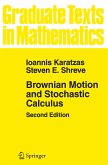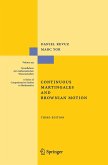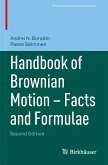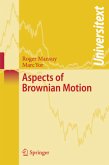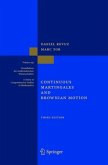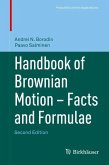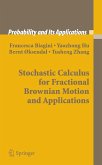From the reviews of the First Edition:
"This excellent book is based on several sets of lecture notes written over a decade and has its origin in a one-semester course given by the author at the ETH, Zürich, in the spring of 1970. The author's aim was to present some of the best features of Markov processes and, in particular, of Brownian motion with a minimum of prerequisites and technicalities. The reader who becomes acquainted with the volume cannot but agree with the reviewer that the author was very successful in accomplishing this goal...The volume is very useful for people who wish to learn Markov processes but it seems to the reviewer that it is also of great interest to specialists in this area who could derive much stimulus from it. One can be convinced that it will receive wide circulation." (Mathematical Reviews)
This new edition contains 9 new chapters which include new exercises, references, and multiple corrections throughout the original text.
"This excellent book is based on several sets of lecture notes written over a decade and has its origin in a one-semester course given by the author at the ETH, Zürich, in the spring of 1970. The author's aim was to present some of the best features of Markov processes and, in particular, of Brownian motion with a minimum of prerequisites and technicalities. The reader who becomes acquainted with the volume cannot but agree with the reviewer that the author was very successful in accomplishing this goal...The volume is very useful for people who wish to learn Markov processes but it seems to the reviewer that it is also of great interest to specialists in this area who could derive much stimulus from it. One can be convinced that it will receive wide circulation." (Mathematical Reviews)
This new edition contains 9 new chapters which include new exercises, references, and multiple corrections throughout the original text.
From the reviews of the First Edition:
This excellent book is based on several sets of lecture notes written over a decade and has its origin in a one-semester course given by the author at the ETH, Zürich, in the spring of 1970. The author's aim was to present some of the best features of Markov processes and, in particular, of Brownian motion with a minimum of prerequisites and technicalities. The reader who becomes acquainted with the volume cannot but agree with the reviewer that the author was very successful in accomplishing this goal...The volume is very useful for people who wish to learn Markov processes but it seems to the reviewer that it is also of great interest to specialists in this area who could derive much stimulus from it. One can be convinced that it will receive wide circulation.
H.J. Engelbert, MathSciNet
From the reviews of the second edition:
"This monograph is a considerably extended second edition of K.L. Chung's classic 'Lectures from Markov processes to Brownian motion' ... . Adding to Chung's masterpiece is a formidable task; the new chapters by Walsh capture the spirit of the original and give a gentle, inspiring and eminently useful introduction to Ray processes, time reversal and duality." (René L. Schilling, Zentralblatt MATH, Vol. 1082, 2006)
"The volume under review is the union of two distinct, albeit complementary, works. ... there are a number of interesting examples in the more familiar world of Markov chains which the reader can use to gain insight into the new ideas. ... If I were asked to recommend a book to beginners who wished to immerse themselves in the subject and emerge in a fit state to tackle the contemporary literature, then I would choose this volume without hesitation." (David Applebaum, The Mathematical Gazette, Vol. 92 (523), 2008)
This excellent book is based on several sets of lecture notes written over a decade and has its origin in a one-semester course given by the author at the ETH, Zürich, in the spring of 1970. The author's aim was to present some of the best features of Markov processes and, in particular, of Brownian motion with a minimum of prerequisites and technicalities. The reader who becomes acquainted with the volume cannot but agree with the reviewer that the author was very successful in accomplishing this goal...The volume is very useful for people who wish to learn Markov processes but it seems to the reviewer that it is also of great interest to specialists in this area who could derive much stimulus from it. One can be convinced that it will receive wide circulation.
H.J. Engelbert, MathSciNet
From the reviews of the second edition:
"This monograph is a considerably extended second edition of K.L. Chung's classic 'Lectures from Markov processes to Brownian motion' ... . Adding to Chung's masterpiece is a formidable task; the new chapters by Walsh capture the spirit of the original and give a gentle, inspiring and eminently useful introduction to Ray processes, time reversal and duality." (René L. Schilling, Zentralblatt MATH, Vol. 1082, 2006)
"The volume under review is the union of two distinct, albeit complementary, works. ... there are a number of interesting examples in the more familiar world of Markov chains which the reader can use to gain insight into the new ideas. ... If I were asked to recommend a book to beginners who wished to immerse themselves in the subject and emerge in a fit state to tackle the contemporary literature, then I would choose this volume without hesitation." (David Applebaum, The Mathematical Gazette, Vol. 92 (523), 2008)
Aus den Rezensionen zur 2. Auflage: "... Der erste Teil geht auf Vorlesungsnotizen von Chung ... Hauptziel ... ist eine Darstellung der wichtigsten Aspekte der Theorie der Markovprozesse ... mit besonderem Augenmerk auf die Brownsche Bewegung. ... der zweite Teil ... ist eigentlich ein unabhängiges Buch, welches dem Text von Chung einen allgemeineren Rahmen nachstellt, der neuere Entwicklungen berücksichtigt und die Basis verbreitert. ... Hier ist insbesondere die klare Einführung in die Ray-Prozesse hervorzuheben. ... Hier haben wir also zwei Bücher in einem, die anspruchsvolles Material für interessierte Leser in hervorragend zugänglicher Weise darstellen." (Wolfgang Woess, in: Internationale Mathematische Nachrichten, 2008, Vol. 62, Issue 209, S. 63 f.)


